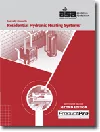One Too Many"

The Glitch
Overview: An installer learns that a hydraulic separator can replace a pair of closely spaced tees and an air separator. He installs the hydraulic separator as shown below, keeping what he feels are standard details for a primary/secondary system.Exercise: Can you spot at least four errors in this layout?

The Fix
1. The boiler circulator should be positioned to push flow into a modulating/condensing boiler with a compact heat exchanger. Such boilers typically generate significantly higher flow resistance relative to traditional boilers with cast-iron heat exchangers. The position of the boiler circulator in the glitch drawing decreases boiler pressure whenever the circulator is operating. If the water temperature in the boiler is high enough, steam flashing may occur.2. The supply temperature sensor placement shown in the glitch drawing will not detect the water temperature supplied to the distribution system. If the flow rate on the right side of the hydraulic separator is higher than the flow rate on the left, mixing will occur within the separator. This will reduce the supply temperature to the distribution system. Ideally, boiler modulation should be based on the load side supply temperature and, thus, the temperature sensor should be moved to the position shown on the fix drawing.
3. There is no need of a “primary loop” on the load side of the hydraulic separator. The details shown in the glitch drawing not only use an extra circulator, they also induce a differential pressure between the top and bottom portions of the loop (due to head loss across the partially closed valve). This pressure differential will attempt to push flow through both load circuits whenever the primary circulator is operating. The fix is to eliminate the primary loop and simply use short, generously sized headers as shown.
4. Add a purging valve on the boiler circuit as shown in the Fix drawing to provide efficient air removal from the boiler at start up.
Links
Looking for a reprint of this article?
From high-res PDFs to custom plaques, order your copy today!






